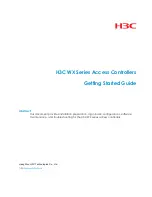
3-6
Cisco Wireless LAN Controller Configuration Guide
OL-9141-03
Chapter 3 Configuring Ports and Interfaces
Overview of Ports and Interfaces
Each interface is mapped to at least one primary port, and some interfaces (management and dynamic)
can be mapped to an optional secondary (or backup) port. If the primary port for an interface fails, the
interface automatically moves to the backup port. In addition, multiple interfaces can be mapped to a
single controller port.
Note
Refer to the
“Enabling Link Aggregation” section on page 3-29
if you want to configure the controller
to dynamically map the interfaces to a single port channel rather than having to configure primary and
secondary ports for each interface.
Management Interface
The management interface is the default interface for in-band management of the controller and
connectivity to enterprise services such as AAA servers. The management interface has the only
consistently “pingable” in-band interface IP address on the controller. You can access the controller’s
GUI by entering the controller’s management interface IP address in Internet Explorer’s Address field.
The management interface is also used for Layer 2 communications between the controller and Cisco
1000 series lightweight access points. It must be assigned to distribution system port 1 but can also be
mapped to a backup port and can be assigned to WLANs if desired. It may be on the same VLAN or IP
subnet as the AP-manager interface. However, the management interface can also communicate through
the other distribution system ports as follows:
•
Sends messages through the Layer 2 network to autodiscover and communicate with other
controllers through all distribution system ports.
•
Listens across the Layer 2 network for Cisco 1000 series lightweight access point LWAPP polling
messages to autodiscover, associate to, and communicate with as many Cisco 1000 series
lightweight access points as possible.
When LWAPP communications are set to Layer 2 (same subnet) mode, the controller requires one
management interface to control all inter-controller and all controller-to-access point communications,
regardless of the number of ports. When LWAPP communications are set to Layer 3 (different subnet)
mode, the controller requires one management interface to control all inter-controller communications
and one AP-manager interface to control all controller-to-access point communications, regardless of the
number of ports.
Note
If the service port is in use, the management interface must be on a different Supernet from the
service-port interface.
AP-Manager Interface
A controller has one or more AP-manager interfaces, which are used for all Layer 3 communications
between the controller and lightweight access points after the access points have joined the controller.
The AP-manager IP address is used as the tunnel source for LWAPP packets from the controller to the
access point and as the destination for LWAPP packets from the access point to the controller.
For Cisco 4404 and WiSM controllers, configure the AP-manager interface on all distribution system
ports (1, 2, 3, and 4). For Cisco 4402 controllers, configure the AP-manager interface on distribution
system ports 1 and 2. In both cases, the static (or permanent) AP-manager interface is always assigned
to distribution system port 1 and given a unique IP address. Configuring the AP-manager interface on
the same VLAN or IP subnet as the management interface results in optimum access point association,
but it is not a requirement.
















































